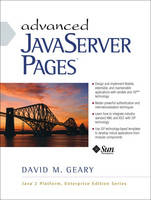
Advanced JavaServer Pages
Prentice Hall (Verlag)
978-0-13-030704-0 (ISBN)
- Titel ist leider vergriffen;
keine Neuauflage - Artikel merken
Thousands of developers have discovered that JavaServer Pages represent the optimal solution for cross-platform web-based development. Now that they've mastered the basics of JSP, many are seeking to deepen and strengthen their expertise. In Advanced JavaServer Pages, best-selling Java author and former JavaSoft developer David Geary delivers the sophisticated enterprise-class techniques they're searching for. Geary tackles JavaServer Pages 1.1 with the same exhaustive, authoritative approach that made his Graphic Java books so successful. He begins with a thorough review of JSP elements, servlets, and JavaBeans; then introduces custom and body tags; and offers sophisticated insights into JSP-based Web application design. Advanced JavaServer Pages includes detailed chapters on internationalization, security, databases, e-mail integration, and Enterprise JavaBeans. For every Java developer interested in creating server-side programs with JavaServer Pages and Sun's servlet technologies.
David M. Geary is best known for his Graphic Java series from Prentice Hall PTR and Sun Microsystems Press, but for the past two years he has been immersed in server-side Java technology. He is a member of the expert group that's defining the standard JSP technology tag library and is also a key contributor to the Apache Struts JSP technology-based application framework.
Preface
Acknowledgements
1. Custom Tag Fundamentals.
Using Custom Tags-The JSP File. Defining Custom Tags-The TLD. Implementing Custom Tags-Tag Handlers. Specifying the TLD in WEB-INF/web.xml. The Tag Life Cycle. Thread Safety. Tags with Attributes. Accessing Page Information. Error Handling. The Tag Package. The Tag Interface. The TagSupport Class: Ancestors, Values, and Ids. Tags with Bodies. Conclusion.
2. Custom Tag Advanced Concepts.
Body Tag Handlers. The BodyTag Interface. The BodyTagSupport Class. Iteration. Scripting Variables. Storing Beans in Page Scope. Specifying Scripting Variable Information. Associating a Tag Handler and Scripting Variables. Using Custom Tag Ids. Body Content. Understanding How Body Content Works. Generating JavaScript. Nested Tags. Locating Ancestor Tags. Sharing Data. Conclusion.
3. HTML Forms.
Forms with Beans. Transmission of Form Data. Textfields, Text Areas, and Radio Buttons. Checkboxes and Options. Validation Client-side Validation with JavaScript. Server-side Validation with JSP. Server-side Validation with Servlets. Server-side Validation with Servlets and JSP Pages. A Form Framework. Facade Design Pattern for HTML Forms. The Framework. Selectable Elements. Validation. Custom Tags. Conclusion.
4. Templates.
Encapsulating Layout. Sections, Regions, and Templates. Optional Content. Role-based Content. Defining Regions Separately. Nesting Regions. Extending Regions. Combining Features. Region Tag Implementations. The Beans. The Tag Handlers. Conclusion.
5. Design.
Model 1. Model 2: An MVC Approach. A Model 2 Example. The Beans. The Deployment Descriptor. Successful Login Use Case. Creating a New Account. Conclusion.
6. Framework.
A Model 2 Framework. The Action Interface. The Action Factory. Action Routers. The Action Servlet. Retrofitting the Original Model 2 Example. Refining the Design. Adding Use Cases. Step #1: Implement a Password Hint Action. Step #2: Implement a Password Hint JSP. Step #3: Add Mappings to the Properties File. Step #4: Modify the Login Failed JSP Page. The Importance of Custom Tags. JSP Scripts. Conclusion.
7. Event Handling and Sensitive Form Resubmissions.
Event Handling for a Model 2 Framework. Sensitive Form Resubmissions. Trapping Form Resubmissions with a Model 2 Framework. Trapping Form Resubmissions Without a Framework. Conclusion.
8. I18n.
Unicode. Charsets. Non-Latin-based JSP Pages. Multilingual JSP Pages. Locales. Resource Bundles. List Resource Bundles. Using Constants for Resource Keys. Property Resource Bundles. Multiple Resource Bundles. A Bundle Cache. Formatting Locale-Sensitive Information. Dates and Times. Numbers, Currency, and Percents. Messages. Browser Language Preferences. Detecting Locales. Locating Resource Bundles. Custom Tags. A Message Tag. A Format Tag. Conclusion.
9. Security.
Servlet Authentication. Principals and Roles. Declarative Authentication. Portability. Types of Authentication. Basic Authentication. Digest Authentication. Form-Based Authentication. SSL and Client Certificate Authentication. Customizing Authentication. Resin. Tomcat 4.0. Web Application Security Elements. Programmatic Authentication. Conclusion.
10. Databases.
Database Creation. Data Sources. Database Custom Tags. The Query Tag. The ColumnNames Tag. The Columns Tag. The Rows Tag. The Release Tag. Connection Pooling. Using a Connection Pool. Creating a Connection Pool. Implementing a Simple Connection Pool. A More Capable Resource Pool. Prepared Statements. Transactions. Scrolling Through Result Sets. Conclusion.
11. XML.
Generating XML. Generating XML with Beans. Beans That Generate Their Own XML. Generating Beans from XML. Postprocessing XML. Parsing XML. Simple API for XML (SAX). SAX Custom Tags. Document Object Model (DOM).DOM Custom Tags. Transforming XML. Using JSP and XSLT Together. Using XSLT in a Custom Tag to Produce HTML. Using XSLT to Produce JSP at Compile Time. Using XSLT at Compile Time Vs. Runtime. Using Xpath. Conclusion.
12. A Case Study.
The Fruitstand. The Homepage. Going Shopping. The Storefront. The Shopping Cart. The Checkout. The Purchase. The Model 2 Framework. A The Model. The Views-JSP Pages and Templates. The Controllers-Servlets and Actions. Internationalization. Authentication. HTML Forms. Sensitive Form Resubmissions. SSL. XML and DOM. Conclusion.
Servlet Filters.
Index.
| Erscheint lt. Verlag | 4.7.2001 |
|---|---|
| Verlagsort | Upper Saddle River |
| Sprache | englisch |
| Maße | 177 x 235 mm |
| Gewicht | 971 g |
| Themenwelt | Informatik ► Programmiersprachen / -werkzeuge ► Java |
| Mathematik / Informatik ► Informatik ► Web / Internet | |
| ISBN-10 | 0-13-030704-1 / 0130307041 |
| ISBN-13 | 978-0-13-030704-0 / 9780130307040 |
| Zustand | Neuware |
| Haben Sie eine Frage zum Produkt? |
aus dem Bereich


